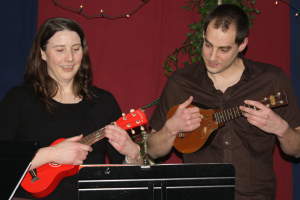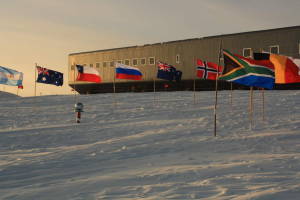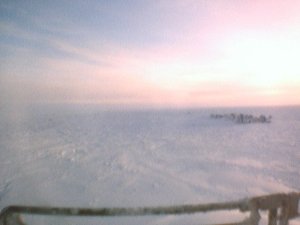As I write this report, the Sun is up ! That was not completely obvious as I will explain later,
but it is definitely daylight again. In the little weather box above it is still marked as
below horizon
because for a monthly report I take the average value of the sun altitude for the whole month. This value is
usually consistent with its altitude on the 15th of the month. On that day, the Sun was still 1.5°
below the horizon. This is also why the Sun appeared above the horizon on the March report.
So the Sun supposedly reached our sight on the 22nd, but unfortunately we were caught
in a major storm since half September, and lasted till the 29th. That is when we finally saw it. The
effect on us all was pretty surprising. As I already said before, living in the dark does not seem
to be a problem. We all enjoyed ourselves during the night, the Aurora's were beautiful, some people
began to be get "toasted" at the end but that was from the isolation, they are still grumpy now.
But as soon as the Sun should have been visible but wasn't due to the blizzard, everyone became nervous.
I believe that is from the unfulfilled expectations rather than the lack of UV's. As a friend of
mine very truly told me, the suicide rate is higher in April because people expect the weather to become
nice and warm again but it is, in fact, still rainy and cold.
So there we were all, expecting the Sun to come up every day, and finally on the 29th of September
the wind died, and everyone on station became relaxed and happy again. We all sat in the galley on
that very moment, with a glass of beer, sunglasses and a smile on our faces. This was definitely
one of these strong moments with my second family here, that I'll never forget.
|
Here is a picture of me behind my desk in my office on that day. Because it is so low
on the horizon, the Sun has this very characteristic yellowish glow that you can usually see
in the very early morning for a few minutes. Here this effect lasts for days.
|

|
I thought I had to add a little scientific touch to this website too, so here it is.
Since the 30's, the industrialized world rejected huge amounts of chlorine in the atmosphere, especially
under the form of Chlorofluorocarbons (CFC's). This is responsible for the famous hole in the ozone
layer that is right above me. So how this works is pretty interesting. Chlorine (Cl) reacts with ozone
(O
3) to form Chlorine Oxide (ClO) and molecular Oxygen (O
2). The equation is simple :
Cl + O
3 => ClO + O
2. In short this means that the ozone disappears. But with the
help of Sun light, that wicked Chlorine Oxide will interact
again with another ozone molecule to form
a new single Chlorine atom (ClO + O
3 =>
Cl + 2 O
2). You get it, that resulting
single Chlorine atom is then the start of a new destructive cycle of more ozone. To summarize, one single
Chlorine atom can remain active for years and years, slowly eating up the ozone layer that protects us from
nasty solar radiation.
And here is the scientific fact that my friends from the NOAA (National Oceanic and Atmospheric Administration)
were able to prove: during the winter, there is no cycle reaction, because there is no Sun (duh!) and it is
too cold. This means that CFC's build up here, concentration increases until the first Sun beams warm them
up. At that point (which is right now), most of the ozone disappears above the Antarctic Plateau in one huge,
continent wide, atmospheric chain reaction and over the time of just a couple of weeks.
Eventually, everything stabilizes in the summer, but at this very moment now, it is
not a good
idea to expose any skin outside or forget your sunglasses. It would burn you immediately and can cause
cancers, according to what the doctor said.
But enough boring science, let's talk about the parties !
First of all, a little comment about that famous movie that we had the chance to watch before it's
official release because the story takes place at our Amundsen-Scott South Pole base.
I am not allowed to talk too much about it, in fact, and I won't because my opinion won't help to
make the movie attractive. Nothing is anywhere close to the reality of our life here, but I
guess that is why it is called a fiction. Although, if it really is a fiction, it lacks UFO's, aliens
and space ships... But the party that we organized for that evening what tremendous. The whole station
(except the poor power plant babysitter) was gathered in the gym, yelling comments, cheering and
screaming at every ridiculous detail. It was really a good laugh.
Anyway, I don't think this movie will make it in the European movie theaters, but if you ever
plan to loan it, please don't forget that
it is a fiction. There is no US marshal and there are
no cosy rooms with fancy decoration and individual showers at pole.
Of course,
THE big event this month was sunrise diner. So again, like for sunset and mid-winter,
we brought out the candles and the sharp looking shirts, and gathered around one single long table
for the appetizers, meal, desert and wine. The meal itself was very complex, and I can't remember
every single flavor, but it was Indian food. And after eating dull canned food for months, this
was pretty amazing. The cooks here are really talented.
After the dinner, the party went on with an "open mic" evening. This basically means that a little
stage is set up, and anyone who has anything to say, to sing or to show is welcome to do so. So we
had a very interesting blend of poetry, music and theater plays.

|
This is a picture of our Kiwi Doctor Jude and myself playing the Ukulele.
|
Another thing to mention here is that every Saturday evening, after dinner, we have the so-called
science lectures. Since we are not that many scientists on station, we invited other people to
talk about their travel experiences instead. Well that was a great idea. The crew this winter seems to
be astonishing well-travelled, and I learn a lot more about the world than I'd expected.
So far, we had stories from India, South America, the Rocky Mountains, the Antarctic Dry Valleys
and many more.
As I already explained in the previous report, now that the Sun is rising, the temperatures are rising too
and the storm season is back for 2 months. And indeed, it
is back. On the 10th of September, an
impressive high pressure front came along (remember, high pressure means bad weather here) with
very strong winds and the now famous "white out" effect (where you can hardly see your own feet).
It was so bad that the station manager had to send a warning to the community, asking us not to leave
the station unless it was absolutely necessary. Unfortunately for me, I had to repair something on the
roof of the IceCube Lab on that particular day.
So with extreme precaution, tied in a fall protection harness I climbed the ladder, reached the edge,
frostnipped my cheekbones, nose and fingers while facing the wind when trying to secure myself on the rope,
saw the anti-slip mats (bolted to the roof) blow away, and decided that this was not safe. According
to the meteorology department, on that day the wind peaked at 42 knots, which is very close to the
all-time record here at pole. It does not seem that big, but in the middle of a desert, with
nothing to stop it, on top of a hill and when it is -60°C, I learned my lesson: just listen to
the station manager.
Let's give a little more information about the meteorology department and their role here.
Two people are working shifts, to have a 24 hours availability. They provide current
local weather information for the incoming and outgoing flights in the summer, and also make forecasts
for us to use when heading outside. A storm can come within an hour here, and if you are not aware that
one is coming when going to your lab, you might be stuck there for a few days. So
on this forecast for the 3rd of September
you can see what it looks like. How it works would be a little long to explain here but in essence,
you have a 5 days forecast of the winds (direction and speed) temperatures and overcast. Wind and
overcast give you the "white out" effect, whereas wind and temperature give you the cold and time you
can actually spend outside without risking hypothermia. Oh, by the way, I already explained this, for
me the "wind chill" value does not mean anything, but on this plot you can see that this value
reaches the bottom of the plot, which is -105°C.
Anyway, I have been working outside more and more lately, burning all the fat I've built up during
the winter, and I really enjoy it. It is gorgeous outside. Here are some picture.
|
Now that it's light enough and that the temperatures are reasonable again, it is time
to do the snow shoveling work we've been putting aside for months at the IceCube Lab.
This is a picture of me after shoveling
for an hour. Thanks to Doctor Ella for the picture.
|

|

|
You probably remember my bad experience of sleeping in the tent. Well the tent was still there
when the Sun rose, and we had to put it away because it was right next to the ceremonial pole
marker where the flags are supposed to be. Here is a little movie made by our very talented
Jeremy Johnson. It is short but it shows the Sun below the horizon and the deep orange light
that it produces.
|
You know that there is this tradition of rising a flag in the morning and lowering it in the
evening. Well here the morning is in September and the evening is in March. So just after sunrise we
set the flags up again around the ceremonial pole marker (where the tent was).
I had to work at the IceCube Lab during the ceremony, but here are the flags again. They
are brand new ones, last year's flags are auctioned amongst the crew members.
I am definitely not as talented for photography as some of my co-winter-overs, but
I try hard to learn from them. Here
is one of my attempts to make an artistic photo, with the the Sun right on the red
circle of the Japanese flag (supposedly representing the Sun), and
this is to show once more the desert
we are living in.
|

|
Other than that, I've been playing a bit with a web cam I bought before coming down, and set up
a little system that, I thought, would make me look good. The idea was to film the sunrise.
So what I did was to take a picture of outside every 5 minutes for several days and stitch them all
one after then other. And that worked ! But unfortunately, we were in the storm during the
whole sunrise, and it is a bit over exposed.

|
The camera was fixed inside the IceCube Lab and pointing towards our (local grid) South. So
the buildings in the back are from the IceCube Drill Camp. It is blurry and over exposed, so
the only thing this video tells us is:
- The Sun only spins around us horizontally in 24 hours, and gets a little step higher every day
- When it is stormy, you can't even see where the Sun is
- I am not a very talented engineer either...
I did not count the number of Sun rotations, but I left the system run for about 2 weeks.
|





